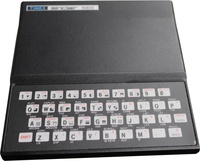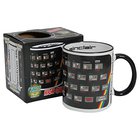Timex Sinclair 1000
| Home > Browse Our Collection > Computers > Timex > Timex Sinclair 1000 |
|
The Timex Sinclair 1000 (TS1000) was the first computer produced by Timex Sinclair, a joint-venture between Timex Corporation and Sinclair Research. It was launched in July 1982. The agreement gave Timex exclusive marketing rights to the ZX81, who were making the computer in their Dundee factory. An article from the Electronics Times on 18 February 1982 writes that "Timex will pay Sinclair a royalty of 5% for every unit sold, both on machines designed by Sinclair and units which have been modified by Timex. Sinclair will also receive a 5% royalty if Timex supplies the machines with his own version of Basic, which it plans to do initially, and 2.5% if it provides software from another source... When sales have reached a satisfactory level Sinclair's Boston office, which has been selling 15000 units a month by mail order, will stop handling the ZX81". The TS1000 was a slightly-modified Sinclair ZX81 with an NTSC RF modulator instead of a UK PAL (units sold in Portugal have a PAL RF modulator) device and the onboard RAM doubled to 2K. The TS1000's casing had slightly more internal shielding but remained the same as Sinclair's, including the membrane keyboard. It had black-and-white graphics and no sound. It was followed by an improved version, the Timex Sinclair 1500. Like the Sinclair ZX81, the TS1000 used a form of BASIC as its primary interface and programming language. To make the membrane keyboard less cumbersome for program entry, the TS1000 used a shortcut system of one-letter "keywords" for most commands (e.g. pressing "P" while the cursor was in "keyword mode" would generate the keyword "PRINT"). Some keywords required a short sequence of keystrokes (e.g. SHIFT-ENTER S would generate the keyword "LPRINT"). The TS1000 clued the user in on what to expect by changing the cursor to reflect the current input mode. The TS1000 sold for $99.95 in the US when it debuted, making it the cheapest home computer to date at the time of its launch (its advertising angle was "the first computer under $100".) This pricing initiated a price war with Commodore International, who quickly reduced the price of the VIC-20 to match and later announced a trade-in program offering $100 for any competing computer toward the purchase of a Commodore 64. Since the TS1000 was selling for $49 by this time, many customers bought them for the sole purpose of trading it in to Commodore. The black-and-white display showed 32 columns and 24 lines, 22 of which were normally accessible for display, with 2 reserved for data entry and error messages. The limited graphics were based on geometric shapes contained within the operating system's non-ASCII character set. The only form of long-term storage was a home tape cassette recorder. The 16K memory expansion sold for $49.95. A shortage of the memory expansions coupled with a lack of software that would run within 2K meant that the system had little use for anything other than an introduction to programming. Home computer magazines of the era such as Compute! showed enthusiasts how to interface the computer with various kinds of equipment, providing the opportunity for learning about early speech synthesis technology through a Speak & Spell, robotics control through the memory port, and scrolling text displays for advertising. Over time, the TS1000 spawned a cottage industry of third-party add-ons designed to help remedy its limitations. Full-size keyboards, speech synthesizers, sound generators, disk drives, and memory expansions (up to 64K) were a few of the options available. Languages such as Forth and Pascal, as well as BASIC compilers and assemblers augmented the TS1000's programming possibilities. Microcomputing magazine published an article in April 1983 decrying the membrane keyboard ("The designers of the Timex-Sinclair 1000 ... reduced this important programming tool to a fraction of the required size") and describing how to wire up external full-size keyboards. Type Home computer Our model is missing the sticker with the model number and a serial number, but is otherwise in excellent condition and complete with the original packaging and manual. Manufacturer: Sinclair Comment on This Page Other Systems Related To Timex Sinclair 1000:This exhibit has a reference ID of CH44376. Please quote this reference ID in any communication with the Centre for Computing History. |
|

























